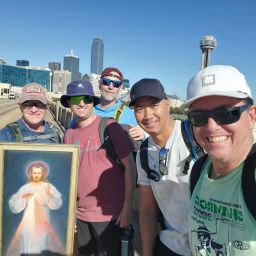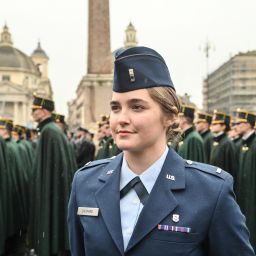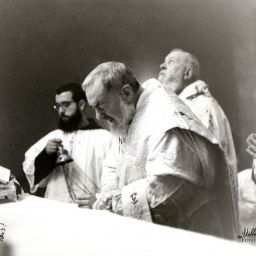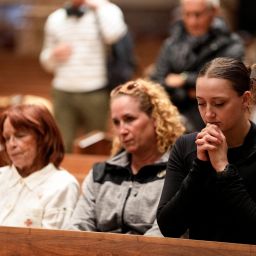By Jack Figge
OSV News
A small group of priests serve one of the largest archdioceses in the United States. But their parish could be as far away as a military base in Japan, or be confined to serving on a warship.
They are U.S. military chaplains.
Wherever U.S. soldiers are deployed, Catholic chaplains faithfully serve the spiritual needs of the men giving their lives in service to the United States.
Father Marcel Taillon, the vocations director for the U.S. Archdiocese for the Military Services, knows firsthand the huge task that serving 1.8 million Catholics spread across the world requires.
“We are the archdiocese that covers the whole world; we serve anyone in the United States military,” Father Taillon told OSV News. “There’s 1.8 million Catholics in the military, and we have to supply sacramental and chaplain, you know, chaplains, priests for them.”
Every day, Father Taillon works with members of the military, seminarians, and even priests who are discerning a potential call to serve as chaplains. Prior to serving as the vocations director for the military archdiocese, Father Taillon served as the vocations director for the Archdiocese of Baltimore. He says that it is all the same discerning process.
“It is the same discernment process for every human person; some of them are just attracted to chaplaincy, right? So they’re attracted to serving as chaplains, but first they also have to discern celibacy, priestly life,” Father Taillon said. “It’s the same priesthood that’s outside the military. It’s the same priesthood of Christ. So it’s the same sort of discernment process. It’s just different because there is this attraction, calling from Jesus, to serve military families.”
While the Archdiocese for the Military Services has its own archbishop, auxiliary bishops, diocesan staff, and structures, it does not have any of its own priests. All of the priests who serve as military chaplains have been ordained to the priesthood for their home dioceses and are, in effect, on loan to the military archdiocese for a brief time.
“Once a man is ordained, they have to serve three years in a regular parish in their home diocese. Then, after three years, the expectation is a five-year minimum service as a military chaplain, in whatever branch they’ve been preparing for,” Father Taillon said.
“We don’t have our own seminaries. They’re all co-sponsored. Every Catholic chaplain in the United States military belongs to another diocese or religious community. Basically, these dioceses allow us to borrow or share, in a sense, their locally incarnated priests with us, or religious priests,” Father Taillon continued.
The process to become a U.S. military chaplain often begins well before a man is ordained a priest. Sometimes, they begin discerning the call to chaplaincy before even entering seminary; other men feel the call to minister to military members while in the seminary.
“My primary work as vocation director is to support men discerning who are currently (on) active duty in all the branches,” Father Taillion said. “I also work with men already in seminary formation at different levels who feel called by Jesus to consider chaplaincy. They’ll often check with their local bishop, check with their local vocation director, and with permission, they’ll start to discern with us.”
Father Taillon recently directed the military archdiocese’s annual fall discernment retreat held at St. Mary’s Seminary in Baltimore. Hosted by Archbishop Timothy P. Broglio, who heads the military archdiocese, the Oct. 31-Nov. 3 retreat was attended by a record 30 prospective chaplains from more than two dozen dioceses and military installations throughout the United States, according to the archdiocese. Of the 30 discerners, it said, 22 are already serving in the military but considering taking on the new role.
When a man has been approved to pursue serving as a chaplain, he will be co-sponsored by both the Archdiocese for the Military Services and their home diocese. During seminary formation, he will receive formation from his home diocese and special formation provided by the military archdiocese.
“Right now the Archdiocese of Military Services has 37 co-sponsored seminarians,” Father Taillon told OSV News. “In order to be a chaplain (in the) military, you have to have a sponsoring home diocese or religious community. Every one of our seminarians belongs half to us and half to their local diocese. So we kind of split the costs of the education. It’s kind of like an ROTC program. We do fraternity building with them and provide formation, but they study where their home diocese sends them.”
Father Jeffrey Paveglio has served as an Army chaplain for 10 years, six as reserve in the National Guard, and four as an active-duty chaplain. His greatest joy is being with those he ministers to day in and day out and seeing the conversions that happen.
“The greatest joy is just bringing the sacraments to soldiers, bringing them hope in difficult circumstances. There’s a lot of challenges that the soldiers face. I was in a battalion that had a lot of suicide and suicidal ideation and things like that, and just seeing soldiers go from that to really, kind of getting a handle on their lives, it was beautiful,” Father Paveglio said. “A lot of conversions happen. It’s a missionary field.”
Now, Father Paveglio is tasked with finding the next generation of Army chaplains as an Army chaplain recruiter. He travels to seminaries and dioceses across the country, talking to seminarians and priests about what it takes to serve.
“We are looking for men who are holy, who are faithful, who love the Church and love Jesus and want to serve and have a heart for service,” Father Paveglio said. “They need to be healthy enough and fit enough to meet army standards. We need priests who can keep up with their soldiers. It’s really crucial that our priests are able to keep up with the soldiers, because if they don’t, they lose access and credibility.”
Like all military chaplains, Father Paveglio served in a parish prior to his military service. He has noticed one key difference in these ministries: In the military, he lives with his parishioners.
“The biggest difference is that I see my soldiers, my parishioners, every day; I see almost all of them every day, unlike at a parish,” Father Paveglio said. “I have access to non-Catholics in a way that most priests do not have. And so that’s where the kind of opportunity for evangelization comes in, because a lot of these soldiers are open to faith.”
By being embedded in battalions or on ships, these priests are granted unique access to the lives of these men. Through this access, they are able to have tough conversations and support the men and women serving in the U.S. military.
“It’s a worthy mission. It’s a call within a call, and it’s very legitimate,” Father Taillon said. “Certainly, in the world we live in today, with the problems, especially wars and violence and religious freedom crises and all these things, we need a good military, and a good military is helped by having good chaplains, who are able to boost the morale and set a good example, thereby boosting the integrity of the troops who serve us.”
Cutline for featured image: Father Lukasz J. Willenberg, a U.S. Army chaplain, greets new recruits in this undated photo. A priest of the Diocese of Providence, R.I., he was stationed at Fort Leonard Wood, Mo., where he served as a chaplain in the Basic Combat Training unit, welcoming 600 new recruits each week for a 10-week cycle of training. (OSV News photo/CNS file photo, courtesy Rhode Island Catholic)








